SWOT Analysis in Healthcare: A Self-Exam to Identify Primary Areas of Focus
Posted on ,
Business marketing books are often aimed at MBAs who understand marketing jargon, not busy medical practitioners. As a result, you may not fully understand the steps necessary for growing your medical practice and attracting new patients.
You may have survived so far with a great location, trained staff, and excellent patient care. While hard work and planning are essential for any medical provider, flourishing in today’s highly competitive, ever-evolving consumer healthcare environment takes strategic planning.
And strategic planning requires upfront analysis. That’s where SWOT analysis enters the picture. What is it? And how does it benefit your healthcare practice? In this article, we will answer those questions and more.
What is a SWOT Analysis?
SWOT analysis should be a strategic planning staple for all businesses, including healthcare practices. SWOT is an acronym for the strengths, weaknesses, opportunities, and threats involved in your medical practice.
SWOT analysis is a data-gathering process that combines quantitative and qualitative information. There is no single correct method for SWOT analysis. However, the size of your medical practice, the frequency of strategic planning meetings, your practice goals, and the changing markets are significant factors that affect the process.
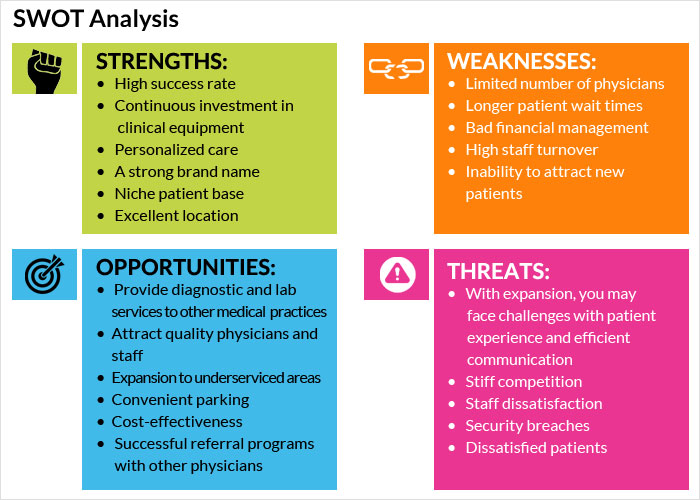

Why You Need SWOT Analysis in Healthcare
SWOT analysis for your hospital or medical practice is like driving a car across the country. You must know where you are starting, understand your car’s present condition, set milestones to help you reach your destination, and anticipate threats you may encounter along the way. Before you start, you need a good map. That’s why you need a SWOT analysis.
A SWOT analysis is also essential for a medical practitioner because it can help you understand your strengths and weaknesses, reveal opportunities you can exploit to expand your practice and recognize threats against your practice that you may have overlooked. Let’s take a closer look at the four pillars of SWOT.
Four SWOT Analysis Process
1. Strengths
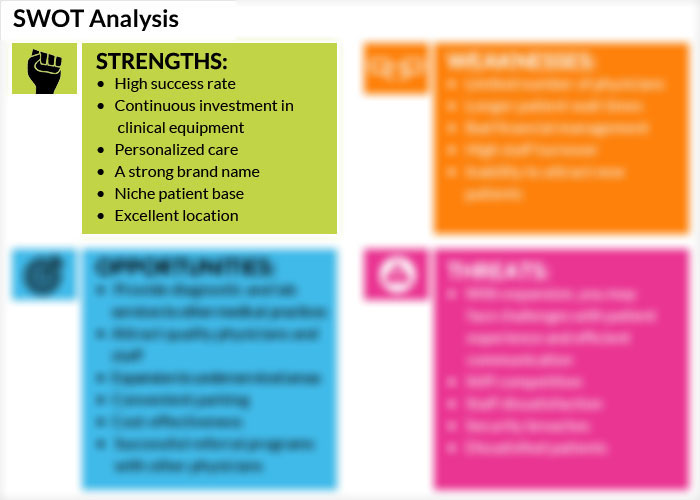
Identify your strengths and leverage their power to establish your brand. You can quickly identify your strengths through dialogues with your staff. Your internal strengths may include skilled and experienced staff, few bad debts, a strong brand name, a solid patient base, an excellent location, etc. Answer questions such as:
- What inspires new patients to come to you?
- What advantages does your practice have over local competitors?
- Do you have access to any unique resources?
2. Weaknesses
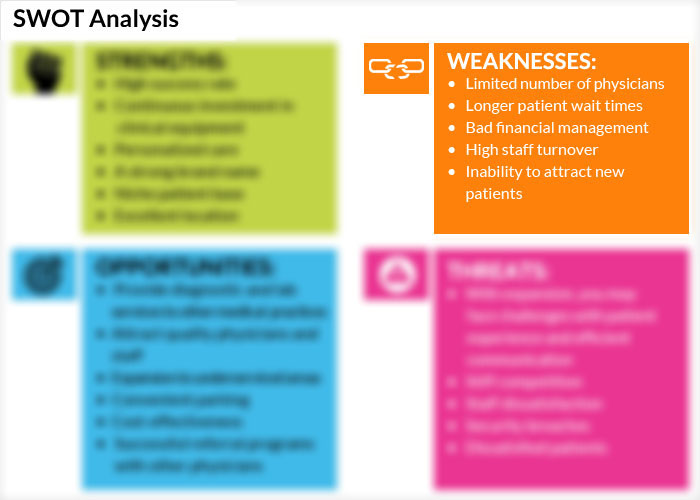

Identify areas of underperformance or weakness in your practice. Be realistic and develop a strategy to address your challenges. Dig deep to understand how your patients perceive your practice. Some typical examples of weaknesses in medical practices include staff shortages, long waiting times for patients, poor financial management, high staff turnover, poor location, shabby premises, outdated equipment, and inability to attract new patients. Answer questions such as:
- What factors cause you to lose patients or prevent you from attracting new ones?
- How do you measure up against competitors?
- How do your patients perceive you?
3. Opportunities
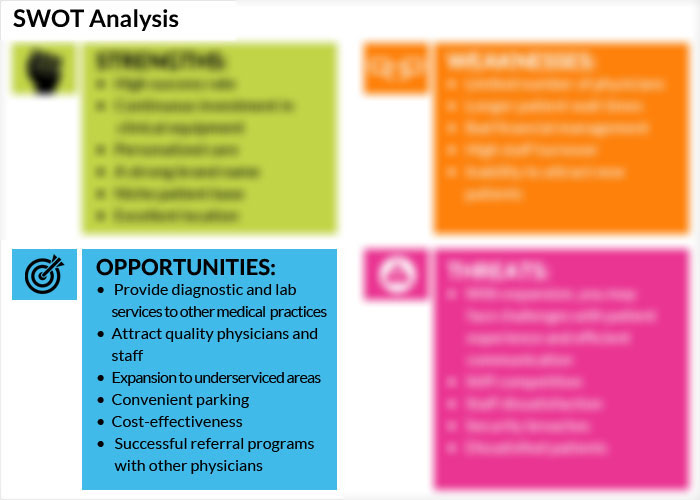
These are favorable external factors that could give you a competitive advantage. Since opportunities typically arise from situations outside your practice, you should always keep an eye on your future possibilities. You can pinpoint and exploit opportunities that can make a huge difference in your ability to compete in your market. Your opportunities might include:
- A market vacated by a competitor
- Availability of new technology
- Changes in your population profile
- Changes in patient needs
- Vulnerability of a competitor
- Lack of dominant competition
- A new, more profitable market segment
- New vertical, horizontal, or niche markets
Use your SWOT analysis to answer questions such as:
- Where are the obvious opportunities facing you?
- Are there any emerging medical trends that may provide opportunities?
- Are there any special market conditions that may open doors for your medical practice?
4. Threats
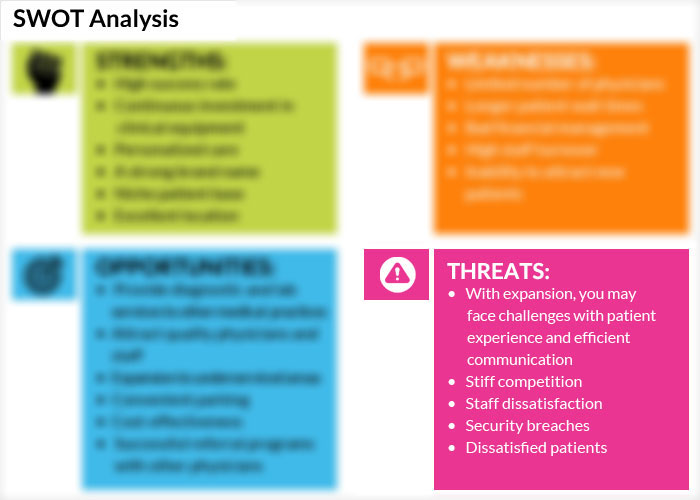
Be realistic about the threats you face when you conduct your SWOT analysis in healthcare. The sooner you accept and face your threats, the sooner you can begin to overcome them. Identify where your practice is and where you expect it to be in the future. Visualize how you will overcome your obstacles. Differentiate minor threats from those with the potential to destroy your practice.

For example, your competitor’s newly renovated office or new equipment may make your practice look old and obsolete. This could result in you losing patients. Anything that gets in the way of your goals is a threat. The purpose of a SWOT analysis is to protect your practice against threats such as stiff competition, staff dissatisfaction, security breaches, or dissatisfied patients. Answer questions such as:
- What difficulties do you face?
- Should you be worried about your competition?
- Are technological advances making your practice look obsolete?
- Could any of your weaknesses threaten your business?
- Can you convert threats into opportunities?
What Are the Four Main Benefits of SWOT Analysis?
1. SWOT prepares you for future obstacles
Healthcare is constantly changing and evolving. If you’re unprepared for coming changes, you’ll find yourself at a competitive disadvantage. When COVID-19 struck in 2020, providers that offered virtual doctor visits had a distinct advantage over those that didn’t.
SWOT is proactive by design. When you and your team discuss future threats that could hinder your progress and hurt profitability, SWOT helps you develop strategies against those threats, possible changes, or uncertainties.
2. SWOT uncovers untapped opportunities
There’s always room for progress in healthcare. Often, your practice’s progress and growth plateaus. This plateau is a sign that you need fresh ideas to help your medical practice reach the next level. SWOT helps you find new possibilities that your competitors may not be aware of. It can supercharge your practice with competitive advantages in profitability and long-term success.
3. SWOT eliminates tunnel vision
It’s easy to be biased toward your practice. It’s easy to think your strengths far outweigh your weaknesses and disregard potentially harmful pitfalls waiting just around the corner. SWOT helps you avoid being short-sighted in your future decisions.
SWOT helps improve your peripheral vision, so you can be more objective in your decision-making. By performing a SWOT analysis, you can identify and turn your weaknesses into strengths.

4. SWOT helps you reverse engineer your competitors
Another great benefit of SWOT is analyzing your competitive landscape. You can conduct a SWOT analysis of your competition just as you did for your practice. Knowing your competitors’ strengths and weaknesses can give you an unmatched market advantage. SWOT can be a great tool if you’re in a competitive environment where multiple providers in the same specialty are competing for the same patients at the same prices.
How To Do A SWOT Analysis in Healthcare
Start by defining success as you see it, both as an individual and a medical practitioner. Be specific about your goals and envision your current practice. Base your SWOT analysis on a vision that emphasizes your strengths and maximizes your opportunities. Let’s look at four steps for conducting SWOT analysis in healthcare:
Step 1: Gather key data
The best-run, highest-performing hospitals are data-driven. The first step of SWOT analysis in healthcare is collecting and assessing important data. This includes patient health records, claims statuses, and funding sources. Focus on key metrics that relate to your strategy. Identify your organization’s capabilities. Is your emergency room slow, or is it like others in your area?
Understand what your organization does well—and what it doesn’t.
Step 2: Complete SWOT categories
Use the data you collected in step one and organize it into the four SWOT categories: strengths, weaknesses, opportunities, and threats. Remember that your strengths and weaknesses are internal factors, while opportunities and threats are external, uncontrollable factors. SWOT is not entirely data-driven, but data can guide your thinking about what you’re good at and what areas need improvement. What are our financial strengths and weaknesses?
Step 3: Develop a SWOT matrix (optional)
Develop a four-box SWOT matrix for your practice or hospital business unit. If you have a small solo practice, this may not be necessary, which is why it’s optional. Your goal is to tailor SWOT to individual departments or teams. This will give you a multifaceted picture of your capabilities instead of generalizations.
Step 4: Complete the analysis and make decisions
Take what you’ve learned in the previous steps and complete your analysis. The insights you gain from the four SWOT categories and the box matrix will inform your strategic planning and influence your decisions. Focus your efforts on deciding how to use your strengths, overcome your weaknesses, minimize threats, and take advantage of opportunities that could move your practice or hospital forward.
Assessment time
Make it a collaborative effort and focus on evaluating your personal ambition along with the practice’s goals. You may find the process a bit uncomfortable, but it will provide you with the ammunition to overcome and respond to weaknesses and threats. Here are some basic ground rules to help you streamline the process:
- Keep your findings in perspective by limiting yourself to a maximum of three factors for each of the four categories.
- Avoid over-complexity and confusion by keeping your replies simple and short.
- Be specific and avoid gray areas.
- Aim to form a competitive business strategy that helps you gain an edge over the competition.
- Brainstorm to convert weaknesses and threats into strengths and opportunities.
- Make sure you have trustworthy information when you are analyzing various elements.
- Avoid making decisions based on opinion or guesswork.
- Prioritize your tasks and reduce the list down to a reasonable size.
- Document a plan of action for each item or goal.
What next?
Once you have brainstormed on all these elements and evaluated your goals, you should have arrived at several tasks or items. These tasks or action items are what you should document in your SWOT chart. Go through the list and set priorities, make commitments, and come up with strategies to deliver on each item. Ask yourselves:
- How can we use our strengths to reap more opportunities?
- Can our strengths help us prepare for the threats?
- Can our weaknesses be converted into opportunities?
You will need to answer these questions before you finalize strategies for achieving goals and positioning your practice for growth.
By using a SWOT analysis in healthcare to assess internal and external factors, your practice can unveil hidden opportunities while maneuvering potential threats.
Are you looking for swot analysis healthcare examples? Contact Practice Builders to discover how we can help you conduct a SWOT analysis or healthcare marketing strategies for your hospital. The result will be increased patient volume, enhanced reputation, and overall growth.

 De-Escalation Tips for Handling Aggressive Patient..
De-Escalation Tips for Handling Aggressive Patient.. Reaching The Right Audience Through Target Marketi..
Reaching The Right Audience Through Target Marketi.. Key Elements Affecting Your Website’s Performanc..
Key Elements Affecting Your Website’s Performanc..